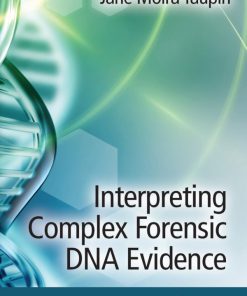Advanced Topics in Forensic DNA Typing Interpretation 1st Edition by John Butler, University Of Virginia ISBN 012405854X 9780124058545
$50.00 Original price was: $50.00.$25.00Current price is: $25.00.
Advanced Topics in Forensic DNA Typing Interpretation 1st Edition by John M. Butler, University Of Virginia – Ebook PDF Instant Download/Delivery: 012405854X, 978-0124058545
Full download Advanced Topics in Forensic DNA Typing Interpretation 1st Edition after payment

Product details:
ISBN 10: 012405854X
ISBN 13: 978-0124058545
Author: John M. Butler, University Of Virginia
Advanced Topics in Forensic DNA Typing: Interpretation builds upon the previous two editions of John Butler’s internationally acclaimed Forensic DNA Typing textbook with forensic DNA analysts as its primary audience. Intended as a third-edition companion to the Fundamentals of Forensic DNA Typing volume published in 2010 and Advanced Topics in Forensic DNA Typing: Methodology published in 2012, this book contains 16 chapters with 4 appendices providing up-to-date coverage of essential topics in this important field. Over 80 % of the content of this book is new compared to previous editions.
- Provides forensic DNA analysts coverage of the crucial topic of DNA mixture interpretation and statistical analysis of DNA evidence
- Worked mixture examples illustrate the impact of different statistical approaches for reporting results
- Includes allele frequencies for 24 commonly used autosomal STR loci, the revised Quality Assurance Standards which went into effect September 2011
Advanced Topics in Forensic DNA Typing Interpretation 1st Table of contents:
Section I. Data Interpretation
Chapter 1: Data Interpretation Overview
- Purpose of This Book
- The Interpretation Process
- Characteristics of Ideal Data
- Guidance for DNA Interpretation
- A Match or Not a Match: That is the Question…
- STR Loci, Kits, and Population Data
- Summary
Chapter 2: Data, Models, Thresholds
- Data Collection in ABI Genetic Analyzers
- Models
- Thresholds Used in STR Typing
- Setting and Using Analytical Thresholds
Chapter 3: STR Alleles and Amplification Artifacts
- Introduction
- Overview of the STR Typing Process
- STR Alleles and Their Measurement
- Variant and “Off-Ladder” Alleles
- Artifacts of STR Allele Amplification
- Non-Template Addition
- Stutter Products
- Null (Silent) Alleles
Chapter 4: STR Genotypes: Heterozygote Balance, Stochastic Thresholds, Allele, and Concordance Studies
- Importance of Genotypes vs. Alleles
- Peak Height Ratios
- Stochastic Thresholds and Allele Drop-out
- Concordance Studies and Null Alleles
Chapter 5: STR Profiles: Multiplex PCR, Tri-Alleles, Amelogenin, and Partial Profiles
- Introduction
- Multiplex PCR Challenges
- STR Profile Evaluation
- Tri-Allelic Patterns
- Gender Identification with Amelogenin
- Partial DNA Profiles
Chapter 6: DNA Mixtures
- General Information
- Tools for Mixture Interpretation
- Elements of Mixture Interpretation
- Resources and Guidance on Mixture Interpretation
- Complicating Factors in Mixture Deconvolution
Chapter 7: Low-Level DNA and Complex Mixtures
- Interpretation Challenges with Low Template DNA
- Low-Quantity and Low-Quality DNA
- Probabilistic Genotyping
- High-Density SNP Arrays?
- More Poor-Quality Samples Being Submitted
- A Complexity Threshold?
Chapter 8: Troubleshooting Data Collection
- Introduction
- Principles and Processes Involved with Capillary Electrophoresis
- Instrument Maintenance & Common Problems
- Recommended Steps for Troubleshooting
- Summary
Section II. Statistical Interpretation
Chapter 9: Statistical Interpretation Overview
- Role of Statistics in Forensic DNA
- Probability
- Statistics
Chapter 10: STR Population Data Analysis
- Introductory Genetic Principles
- Population Data
- Genetic Models and Formulas
- Practical Considerations
- Summary
Chapter 11: DNA Profile Frequency Estimates and Match Probabilities
- Introduction
- Profile Frequency Estimate Calculations
- Likelihood Ratio
- Source Attribution
- Issues with DNA Profile Frequency Estimates
- Summary
Chapter 12: DNA Mixture Statistics
- Introduction
- Different Statistical Approaches to Mixture Interpretation
- Reporting Match Probabilities on Deduced Components
- Random Man not Excluded (RMNE)
- Likelihood Ratios
- Additional Topics
Chapter 13: Coping with Potential Missing Alleles
- Introduction to the Problem
- Probabilistic Genotyping – A Way Forward
Chapter 14: Relationship Testing: Kinship Statistics
- Introduction
- Parentage Testing
- Mutations and Mutation Rates
- Other Topics with Parentage Testing
- Missing Persons & Disaster Victim Identification
- Complex Kinship Analysis
Chapter 15: Lineage Marker Statistics
- Lineage Marker Inheritance Patterns
- Guidance on Interpretation
- Generating Lineage Marker Haplotypes
- Population Databases for Lineage Markers
- Genetic Models and Reporting
- Summary Thoughts
Chapter 16: Laboratory Reports: Communicating Results and Conclusions
- Introduction
- Drawing Conclusions
- Report Writing
- Report & Case Review
- Report Release
- Report Comprehension and Potential Misuse
People also search for Advanced Topics in Forensic DNA Typing Interpretation 1st:
advanced topics in forensic dna typing methodology pdf
advanced topics in chemistry
topics under forensic science
interesting topics in forensic science
advances in forensic taphonomy method theory and archaeological perspectives
Tags:
John Butler,University Of Virginia,Advanced,Topics,Forensic,Typing,Interpretation 1st
You may also like…
Jurisprudence & Law - Criminal Law & Procedure
Forensic DNA Profiling-A Practical Guide to Assigning Likelihood Ratios 1st Edition Jo-Anne Bright
Biology and other natural sciences - Plants: Agriculture and Forestry
History - American Studies
Virginia in the War of 1812 Christopher M Bonin 1476633304 9781476633305
Jurisprudence & Law - Criminal Law & Procedure
Interpreting Complex Forensic DNA Evidence 1st Edition Jane Moira Taupin
Uncategorized
Dehydrogenation Reactions with 3d Metals 1st Edition by Basker Sundararaju 3031489519 9783031489518
Chemistry - Analytical Chemistry
Contemporary Topics in Analytical and Clinical Chemistry volume 3 1st Edition David Hercules












